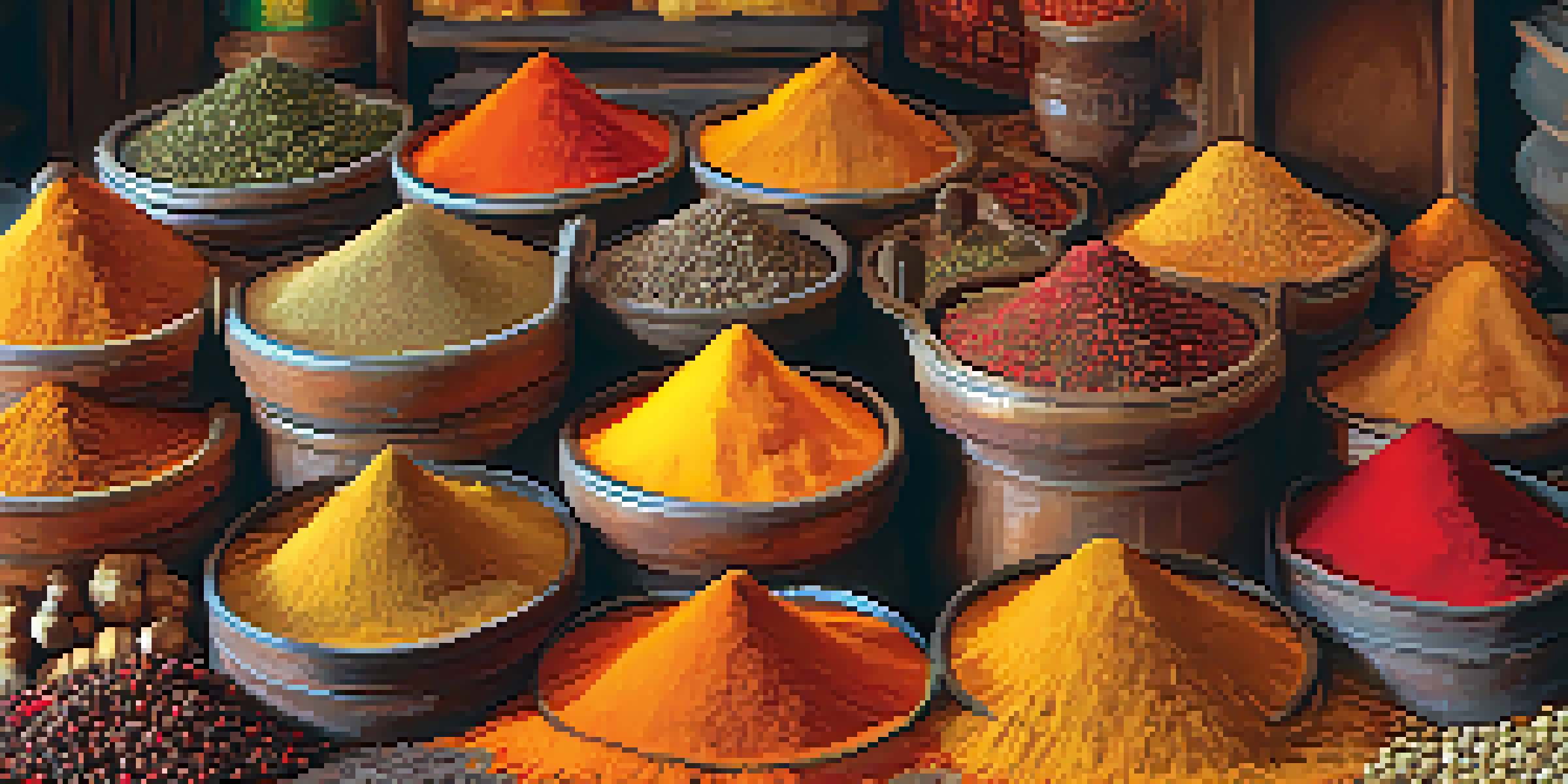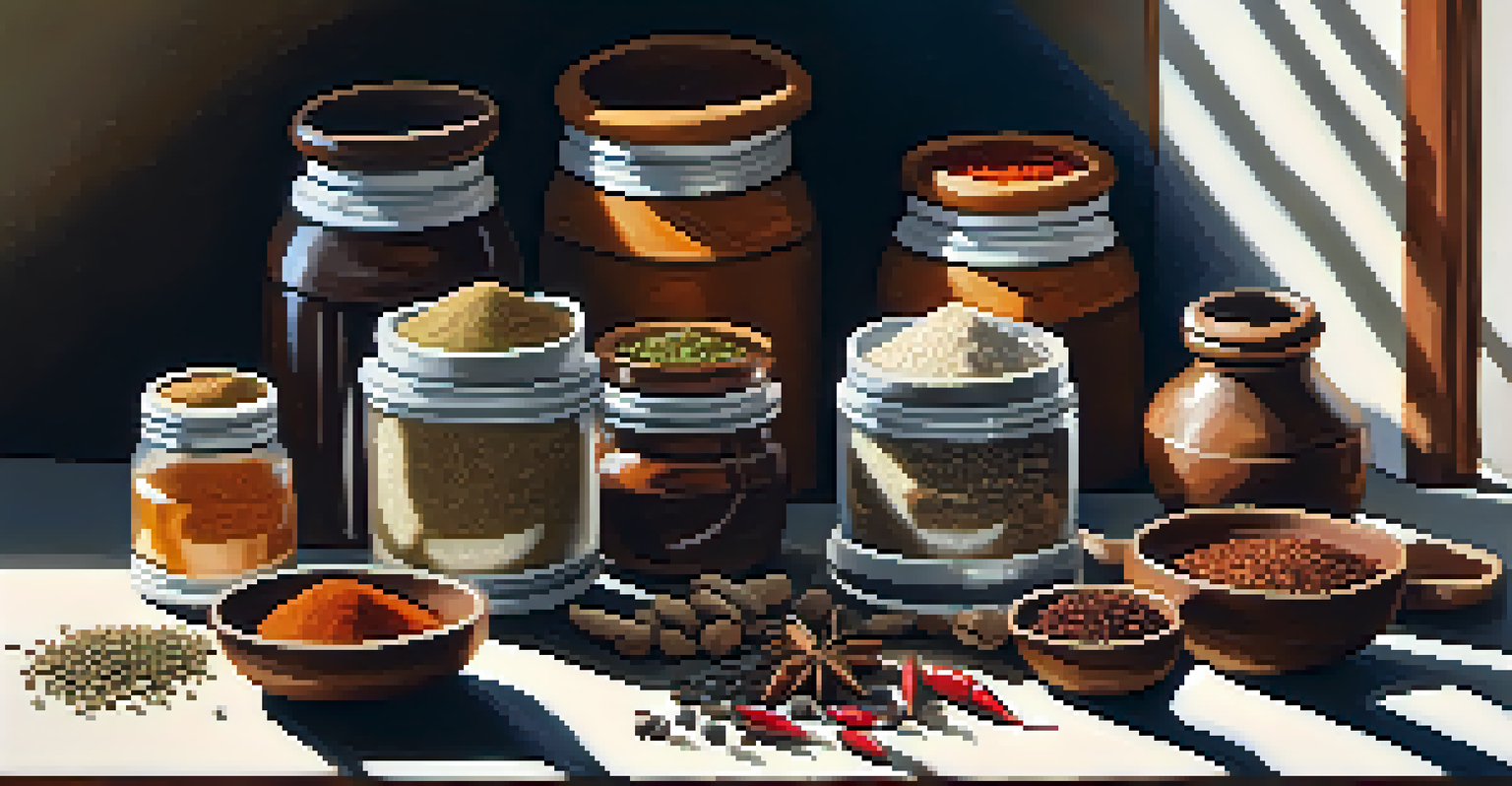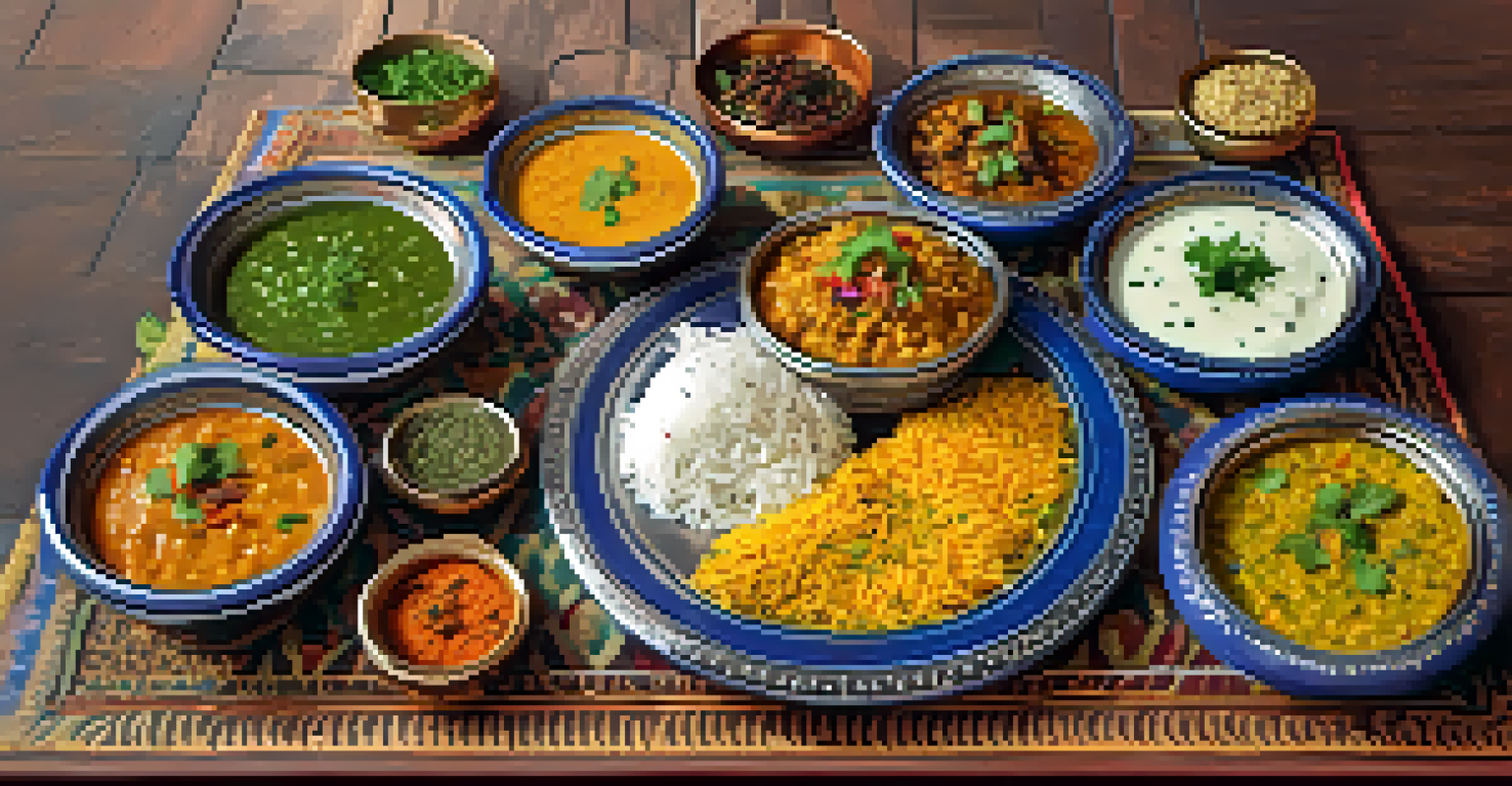Exploring the Spices of India: A Culinary Heritage Journey

The Vibrant World of Indian Spices
India is often referred to as the land of spices, and for good reason. With a rich tapestry of flavors, Indian cuisine boasts a myriad of spices that not only enhance taste but also offer numerous health benefits. From the fiery heat of chili peppers to the aromatic allure of cardamom, these spices tell a story of India's diverse cultures and traditions.
Spices are the most essential ingredient in any dish. They not only add flavor but also enhance the nutritional value of food.
The use of spices in Indian cooking dates back thousands of years, reflecting the country's agricultural bounty and trade routes. Each region has its unique blend of spices, influenced by local ingredients and historical interactions. This regional diversity means that the same dish can taste entirely different across India, showcasing the versatility of spices.
In India, spices are more than just flavor enhancers; they hold cultural significance and are often used in rituals and celebrations. For instance, turmeric is considered sacred and is used in weddings and festivals, symbolizing purity and prosperity. Thus, exploring Indian spices is not just a culinary journey, but also an exploration of its rich cultural heritage.
The Health Benefits of Indian Spices
Many Indian spices are renowned for their medicinal properties, making them integral to both cuisine and wellness. For example, turmeric contains curcumin, a powerful anti-inflammatory and antioxidant. Incorporating turmeric into your diet can help combat various ailments, from arthritis to digestive issues.

Similarly, cumin aids digestion and is often used in traditional remedies for stomach ailments. Coriander is another spice that not only adds flavor but also helps lower blood sugar levels and reduce bad cholesterol. These health benefits make spices a vital part of a balanced diet, promoting overall well-being.
Diverse Spices Reflect Culture
Indian spices not only enhance flavors but also embody the country's rich cultural heritage and traditions.
Moreover, the ancient practice of Ayurveda emphasizes the importance of spices for both physical and mental health. These spices are believed to balance the body's energies, or doshas, leading to a harmonious state. By understanding the health benefits of Indian spices, we can appreciate their role in enhancing our quality of life.
Key Spices and Their Culinary Uses
Some spices stand out for their distinct flavors and versatility in various dishes. For instance, cumin seeds lend a warm, earthy flavor to curries, while garam masala, a blend of several spices, adds depth and richness to many recipes. Understanding how to use these spices can elevate your cooking and bring authenticity to your meals.
Food is not just about sustenance. It's about sharing and connecting with our cultural roots, and spices are the storytellers.
Another essential spice is coriander, which adds a fresh, citrusy note to dishes. Both the seeds and the fresh leaves (cilantro) have their own unique uses, making coriander a staple in Indian kitchens. Additionally, fenugreek seeds provide a slightly bitter taste but are fantastic for enhancing the flavor profile of lentil dishes.
In sweets, cardamom shines brightly, imparting its fragrant aroma to desserts like chai and gulab jamun. Each spice carries its own personality, and learning to balance these flavors can transform a simple dish into a culinary masterpiece. This knowledge not only enriches your cooking but also connects you to the traditions of Indian cuisine.
The Role of Spices in Regional Indian Cuisine
India's vast geography influences the spices used in its diverse regional cuisines. For example, in South India, you'll find a generous use of mustard seeds and curry leaves, which are essential for tempering dishes. Conversely, Northern Indian cuisine often features richer spices like saffron and cloves, reflecting its Mughal heritage.
In coastal areas, seafood dishes are flavored with a variety of spices, including kokum and tamarind, bringing a tangy zest to the plate. Each region has developed its unique spice blends, which are often closely guarded family secrets passed down through generations. This regional diversity is what makes Indian cuisine so vibrant and exciting.
Health Benefits of Spices
Many Indian spices, like turmeric and cumin, offer significant health benefits, promoting overall wellness.
Exploring the regional variations of spices not only enhances your culinary skills but also offers insight into the cultural influences that shape Indian food. This journey through India’s spice landscape allows you to appreciate the intricate connections between geography, culture, and cuisine.
Buying and Storing Indian Spices
When it comes to buying Indian spices, freshness is key. Purchasing whole spices and grinding them at home can significantly enhance flavor and aroma. Many local Indian grocery stores offer a wide selection of spices, often in bulk, allowing you to experiment with different varieties without breaking the bank.
Once you've selected your spices, proper storage is crucial to maintaining their potency. Store them in airtight containers, away from direct sunlight and moisture, to preserve their flavors for as long as possible. A dark, cool pantry is an ideal location for spices, preventing them from losing their vibrant qualities over time.
Additionally, keeping a well-stocked spice rack can inspire creativity in the kitchen. Having a variety of spices on hand allows you to experiment with different flavors and cuisines, making meal preparation an adventurous experience. Embracing the world of Indian spices means opening up a treasure chest of culinary possibilities.
The Art of Blending Spices
Blending spices is an art that can transform a dish from ordinary to extraordinary. In Indian cooking, the practice of creating masalas—spice blends—is essential. Each household may have its unique blend, often tailored to family recipes and personal preferences. Learning to master these blends can be a rewarding experience.
A classic example is the garam masala, which typically includes spices like cinnamon, cloves, and black pepper. This aromatic blend is often added towards the end of cooking to preserve its flavors. Understanding the balance of spices in a blend can elevate your cooking, allowing you to create authentic Indian flavors right in your kitchen.
Regional Variations in Cuisine
The diverse geography of India influences regional cuisine, with unique spice blends that tell the story of local ingredients and traditions.
Experimenting with different ratios and combinations can lead to exciting new dishes. Don't be afraid to play with flavors; cooking is about personal expression as much as it is about tradition. By embracing the art of blending spices, you can develop your unique culinary voice and share the rich heritage of Indian cuisine.
Experiencing Indian Spices Through Cooking
The best way to truly appreciate Indian spices is through cooking. Preparing traditional dishes allows you to experience the vibrant flavors and aromas firsthand. Whether it's a simple dal or an elaborate biryani, every dish tells a story through its spices, inviting you to connect with the culture.
Consider hosting a cooking night with friends or family, where everyone can participate in creating an Indian meal together. This not only makes for a fun experience but also helps bridge cultural gaps through food. Sharing stories and tips while cooking can enhance your understanding and appreciation of the spices involved.

Finally, don’t shy away from experimenting with spices in your everyday cooking. Incorporating Indian spices into familiar dishes can create delightful twists, making meals more exciting. This culinary journey through Indian spices enriches your kitchen experience and invites you to explore a world of flavor.